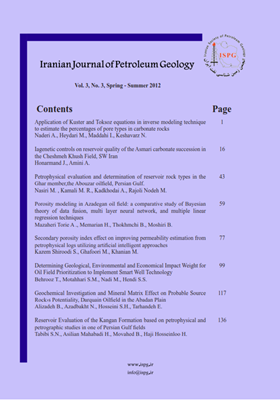Porosity modeling in Azadegan oil field: a comparative study of Bayesian theory of data fusion, multi layer neural network, and multiple linear regression techniques
Subject Areas :عطیه مظاهری طرئی 1 , حسین معماریان 2 , بهزاد تخم چی 3 , بهزاد مشیری 4
1 - University of Tehran
2 - University of Tehran
3 -
4 - University of Tehran
Abstract :
Porosity parameter is an important reservoir property that can be obtained by studying the well core. However, all wells in a field do not have a core. Additionally, in some wells such as horizontal wells, measuring the well core is practically impossible. However, for almost all wells, log data is available. Usually these logs are used to estimate porosity. The porosity value obtained from this method is influenced by factors such as temperature, pressure, fluid type, and amount of hydrocarbons in shale formations. Thus it is slightly different from the exact value of porosity. Thus, estimates are prone to error and uncertainty. One of the best and yet most practical ways to reduce the amount of uncertainty in measurement is using various sources and data fusion techniques. The main benefit of these techniques is that they increase confidence and reduce risk and error in decision making. In this paper, in order to determine porosity values, data from four wells located in Azadegan oil field are used. First, multilayer neural network and multiple linear regressions are used to estimate the values and then the results of these techniques are compared with a data fusion method (Bayesian theory). To check if it would be possible to generalize these three methods on other data, the porosity parameter of another independent well in this field is also estimated by using these techniques. Number of input variables to estimate porosity in both the neural network and the multiple linear regressions methods is 7, and in the data fusion technique, a maximum of 7 input variables is used. Finally, by comparing the results of the three methods, it is concluded that the data fusion technique (Bayesian theory) is a considerably more accurate technique than multilayer neural network, and multiple linear regression, when it comes to porosity value estimation; Such that the results are correlated with the ground truth greater than 90%.


